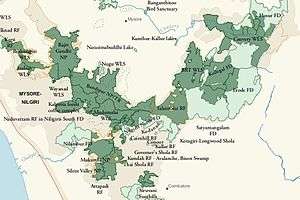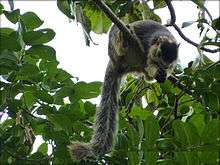Cauvery Wildlife Sanctuary
| Cauvery Wildlife Sanctuary | |
|---|---|
| Bheemeshwari Wildlife Sanctuary | |
|
IUCN category IV (habitat/species management area) | |
|
A view of Cauvery Wildlife Sanctuary during summer | |
 Map of Karnataka | |
| Location | Karnataka, India |
| Nearest city | Mandya |
| Coordinates | 12°10′12″N 77°32′35″E / 12.170°N 77.543°E[1]Coordinates: 12°10′12″N 77°32′35″E / 12.170°N 77.543°E[2] |
| Area | 1,027.53 km2 (396.73 sq mi) |
| Established | 1987 |
| Governing body |
Government of India, MOEF, Karnataka Forest Department |
The Cauvery Wildlife Sanctuary is a protected area located in the Mandya, Chamarajanagar and Ramanagar districts of Karnataka, India. The Cauvery River passes through its midst. It was established on 14 January 1987 under Section 18 of the Wildlife Protection Act 1973 with the objective of providing protection, conservation and development of Wildlife and its environment. The sanctuary spans an area of 102,753 hectares (253,910 acres). On its east, it adjoins Dharmapuri forest division of Tamil Nadu state.
The forest types in the sanctuary are of dry deciduous forest, southern tropical dry thorn and riverine forests; Terminalia arjuna and jambul are the two major species of trees.
Among the many faunal species found in the sanctuary, malabar giant squirrel (Ratufa indica maxima), grizzled giant squirrel (Ratufa macroura) are under the highly endangered category. The sanctuary is also home to many reptile species, 280 bird species which include 19 new species and 25 bird species of Malayan Tropical Dry Zone.
Geography
The sanctuary, established on 14 January 1987 under Section 18 of the Wildlife Protection Act 1973, is spread over an area of 1,027.53 square kilometres (396.73 sq mi)[3] It lies in an elevation range of 125–1,514 metres (410–4,967 ft) (“Ponnachi Betta” is the highest mountain in the centre of the sanctuary[4]) with its northern and southern boundary delimited by the Cauvery River on the Eastern Ghats, which drains from west to east. Its eastern and northeastern borders are bounded by the Tamil Nadu state.[4][5] The river forms the interstate boundary between Karnataka and Tamil Nadu states over a river reach of 73 kilometres (45 mi) with dense forests on both banks. The sanctuary is named after the Cauvery River which flows through it over a total length of 101 kilometres (63 mi).[4] Important places along the river stretch flowing through the sanctuary covering its forested central and eastern parts are the Hogenakal Falls (meaning: "smoking rock" in Kannada language), Mekedatu (meaning: "goats leap"), and Sangam (confluence with the Arkavathi River. An important religious centre within the sanctuary is Muthathi Anjaneya temple.[4] Also located within the sanctuary are an ecotourism fishing resort and the Cauvery Fishing Camp at Bhimeshwari.[6]
The sanctuary is managed by the Deputy Conservator of Forests with four wildlife ranges at Kanakapura, Hanur, Cowdally and MM Hills wildlife ranges. The reserve forests, which are part of the sanctuary, are the Basavanabetta S.F (3,765.50 hectares (9,304.8 acres)), the Chilandavadi S.F (1,987.50 hectares (4,911.2 acres)), the Muggur S.F (2,044.00 hectares (5,050.8 acres)), the Chikkayalur S.F (13,875.00 hectares (34,285.9 acres)), and the Mahadeswara Reserve Forest (31,023.50 hectares (76,660.7 acres)).[4] The boundary of the sanctuary is well demarcated with the surrounding border areas consisting of agricultural lands and forests; the bordering forest areas are: the Kollegal forest division to its west and south, Mandya and Ramanagaram forest divisions to its north, and Dharmapuri Forest division of Tamil Nadu state to its east.[4]
Human habitation inside the sanctuary and within 5 kilometres (3.1 mi) radius of the sanctuary consists of eight enclosed villages and 30 villages respectively with a total population of 39,000 whose main occupation is agriculture. Along the boundary of the sanctuary, a trench is excavated to prevent elephant migration to neighbouring villages and to check damage to agricultural lands.[4]
The nearest rail head to the sanctuary is Ramanagar, which is 25 kilometres (16 mi) away. Bangalore is the nearest airport at a distance of 56 kilometres (35 mi). The road access connecting Muthathi, Bangalore, Harohalli, Kanakapura and Sathanur is a distance of 100 kilometres (62 mi), and linking with M.M.Hills, Bangalore, Maddur and Malavalli is 225 kilometres (140 mi). From Mysore the link is via Kollegal and Hanur, a distance of 145 kilometres (90 mi).[4]
Climate

The sanctuary has a semi-arid climate, where the average temperatures are a minimum of 5 °C (41 °F) and maximum of 38 °C (100 °F), and during summer it touches a maximum of 40 °C (104 °F). The sanctuary receives rainfall both during the Northeast monsoon and Southwest monsoon. The rainfall varies between 750 millimetres (30 in) and 800 millimetres (31 in).[4][7]
Biology and ecology
The sanctuary mainly consists of dry deciduous forest, southern tropical dry thorn and riverine forests.[5][8] Hardwickia binata and Albizzia amara are the dominant forest types. There is hardly any vegetation in the northwestern part while good forests exist in the rest of the sanctuary.[5]
Flora
The dominant species of trees found in this sanctuary are Terminalia arjuna and jambul. The other species of trees found are Albizia amara, Feronia sp., Tamarindus indica, Mangifera indica, Hardwickia binata, Acacia amata and several species of acacia, feronia and ficus trees.[4][5][8]
Fauna

It is home to mammals like elephant (Elephas maximus), wild boar (Sus scrofa), leopard (Panthera pardus), dhole, spotted deer (Axis axis), barking deer (Muntiacus muntjak), sambar (Cervus unicolor), four-horned antelope (Tetracerus quadricornis), black-naped hare (Lepus nigricollis), chevrotain, common langur, bonnet macaque, honey badger (ratel)[5][9] malabar giant squirrel (Ratufa indica maxima), grizzled giant squirrel (Ratufa macroura) which is under the highly endangered category in the state of Karnataka (but under IUCN Red List as near threatened[10]), smooth-coated otter (Lutra lutra)[4][5][11][12] The smooth-coated otter sites in the sanctuary’s river reach were specifically studied. It was noted that the otters inhabited riverine areas which were loosely packed sand and rock without compacted sand, rocks, gravel, and plant cover.[6]
The river Cauvery is also habitat for various species of reptiles like the mugger crocodile (Crocodylus palustris), Indian mud turtles (Chelonia sp.).[5][12] Reptile species in the sanctuary are Indian rock python (Python molurus), Indian cobra (Naja naja), Russell’s viper (Daboia russelii) and banded krait (Bungarus fasciatus). This is also one of the few places to find mahseer (Tor putitora) fish.[5]
Avifauna
The sanctuary is listed as an IBA assessed bird area by the BirdLife International in 2004 which extends over the same semiarid area as the sanctuary. The two most endangered species in the sanctuary are Gyps species of vultures – the white-rumped vulture (Gyps bengalensis) and Indian vulture (Gyps indicus). The four vulnerable species reported are Nilgiri wood-pigeon (Columba elphinstonii), greater spotted eagle (Clanga clanga), white-naped tit (Parus nuchalis) and yellow-throated bulbul (Pycnonotus xantholaemus). Other bird species reported are 25 species of Malayan Tropical Dry Zone which includes the near threatened red-headed vulture (Sarcogyps calvus). The species of least concern reported here is the resident white-bellied blue-flycatcher (Cyornis pallipes).[5]
In a recent bird survey carried out in the sanctuary, reported in January 2014, the total number of bird species identified in the park are 280, which include 19 new species. Some of the notable species reported are: Indian courser, Malabar parakeet, large-billed leaf warbler, green leaf-warbler, western crowned leaf warbler, fairy-bluebird, the Indian blue robin, the yellow-throated bulbul, the crested goshawk, rosefinch, Blyth's swift, Orphean warbler, European bee-eater, and Eurasian crag martin.[13]
Threats
The threats faced in the sanctuary have been recorded to be mostly of recent origin and of low intensity. These low level threats are related to farming and fishing activities, use of forest resources in the form of logging, tree harvesting, extraction of minor forest produce, least degree of recreational disturbance from human activities and low level of natural changes in the form of water harvesting structures. However, the threats from exploitation of biological resources in the form of hunting and capture of animals is assessed as high.[4][5]
Conservation measures
Conservation measures in force in the sanctuary are in the form of patrolling on foot and in jeeps, and functioning of 11 moving anti-poaching camps; two permanent camps have been proposed. Drinking water to wild animals are provided through building of water conservation structures. Fire lines are cut and burnt well in advance before the beginning of the forest fire season; fire lines are created and dry material burnt. Fire watchers are stationed at strategic locations.[4]:17–22 A 10-year conservation plan for the period 2006–16 has been instituted. Zoning of forest into Core, Buffer, and Tourism zones has been planned. The tourism zone has four specific areas – Bheemeshwari and Muthathi, Sangam and Mekedatu in the Kanakapura Wildlife Range, Gopinatham and Hogenakal falls of M.M.Hills Wildlife Range. Administrative set up has been proposed to be reorganized with additional staff.[4]:32–37 Improvement of patrolling paths has been envisaged.[4]:48 To increase awareness among the general public publicity pamphlets are planned, apart from fixing signages and plaques with information on the importance of preservation of wildlife of the sanctuary.[4]:50
References
- ↑ "Cauvery Sanctuary". protectedplanet.net.
- ↑ "Cauvery Sanctuary". protectedplanet.net.
- ↑ Mukharjee, M.; Swaminathan, M. H.; Poornesha, H. C. "Providing more protected space for tigers Panthera tigris: a landscape conservation approach in the Western Ghats, southern India". Oryx. 50: 336–343. doi:10.1017/S0030605314000751.
- 1 2 3 4 5 6 7 8 9 10 11 12 13 14 15 16 "Part – I: The protected area: The existing Situation" (pdf). Forest Department of the Government of Karnataka. Retrieved 5 January 2016.
- 1 2 3 4 5 6 7 8 9 10 "IN186: Cauvery Wildlife Sanctuary". Bridlife International. Retrieved 5 January 2016.
- 1 2 Shenoy, Kausalya; Varma, Surendra; Prasad, K. V.Devi (10 September 2007). "Factors determining habitat choice of the smooth-coated otter, Lutra perspicillata in a South Indian river system" (pdf). Current Science Journal. Retrieved 5 January 2016.
- ↑ Shenoy,K; Varma, S (2006). "Factors determining habitat choice of the smooth-coated otter, Lutra perspicillata in a South Indian river system – ePrints@IISc". current science. Retrieved 7 April 2012.
- 1 2 N,Bhaskaran; K,Senthilkumar; M,Saravanan. "A new site record of the Grizzled Giant Squirrel Ratufa macroura (Pennant, 1769) in the Hosur forest division, Eastern Ghats, In". Retrieved 7 April 2012.
- ↑ S.Gubbi,V.Reddy,H.Nagashettihalli,R.Bhat and M.D.Madhusudhan (2014) "Photographic Records of the Ratel Mellivora capensis from the Southern Indian State of Karnataka" published in: Small Carnivore Conservation, Vol.50, July 2014
- ↑ "Ratufa macroura". IUCN Red List Organization. Retrieved 8 January 2016.
- ↑ Shenoy, Kausalya and Varma, Surendra and Devi Prasad, KV (2006) Factors determining habitat choice of the smooth-coated otter, Lutra perspicillata in a South Indian river system. In: Current Science, 91 (5). pp. 637–643
- 1 2 "Cauvery Wildlife Sanctuary official website".
- ↑ Chandra, N.S. Subhash (14 January 2014). "19 new bird species found in Cauvery wildlife sanctuary". Deccan Herald. Retrieved 5 January 2016.
| Wikimedia Commons has media related to Cauvery Wildlife Sanctuary. |